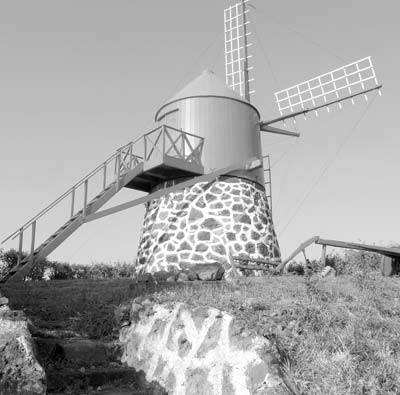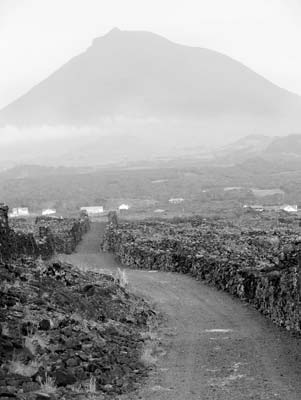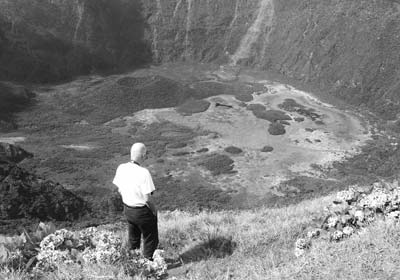Hiking the Azores
by Harvey Hagman, Fort Myers, FL
Below us was a giant volcanic crater, the Caldeira das Sete Cidades, whose 1,000-foot sheer walls drop like green curtains in spots around its 7-mile circumference.
Within its bowl rest mythical volcanic lakes. In sunlight, one is blue, the other green, colored from the tears, according to legend, of a princess forced to part from her shepherd lover.
We were on the island of San Miguel (São Miguel) in the wonderful Azores.
About the islands
San Miguel is the largest of the nine Azorean islands, measuring some 40 by 10 miles. Hiking along a dirt path, we began at Vista do Rei, along the caldera’s rim. The following day, our hike in the other direction offered panoramas of the sea, volcanic cones and pastures dotted with grazing cows.
As we hiked, feeling like we had the islands to ourselves, legends of lost Atlantis flitted across our minds.
The Azores have everything: magnificent volcanoes; green pastures; deep forests; hidden waterfalls; the rolling, blue Atlantic; a seafaring tradition filled with sunken galleons, pirates and sea battles; succulent seafood; baroque churches older than our nation; great whale watching; tasty island wines and cheeses; a running of the bulls; a calendar full of religious festivals, and the world’s friendliest people. William F. Buckley, Jr., called them “the most beautiful group of islands in the world.”
Europe’s westernmost outpost is only a 4-hour flight from Boston or a 2-hour, 800-mile flight from Lisbon.
We, like many visitors, went there to hike amid its astonishing natural beauty (the islands have 50 marked trails, San Miguel alone with 17) and to enjoy its serene, rural accommodations, cabins or rural manor houses near piscinas, rock-encircled swimming areas where the wild Atlantic crashes beyond the protective rocks.
Many islanders speak English as a second language, as a good number emigrated to Canada or the United States after earthquakes or when economic times got tough.
Ponta Delgada
We flew into San Miguel’s capital city, bustling Ponta Delgada, a historic maritime capital harboring churches; convents; monasteries; trim white houses with wrought-iron balconies; 18th-century city gates, and cobbled streets that wind down to its harbor. A new seafront is planned, with dockage for cruise ships plus a yacht basin, bars, discos and restaurants.
Our centrally located hotel, Hotel do Colégio, was once a manor house, then the town’s first private school. A former student transformed it into a charming hotel whose restaurant features fine fusion cuisine.
After our first hike, we visited the pineapple plantation of Dr. Augusto Arruda to taste his pineapple liqueur and learn about the famous pineapples grown in his greenhouses. Brought from South America in the mid-19th century as an ornamental plant, pineapples soon became a major cash crop in the Azores.
Tea was introduced around the same time. In 1878 two Macau tea producers brought the first tea plants to the attractive town of Ribeira Grande, which still produces excellent tea. We sipped savory teas at the Fábrica de Chá Gorreana, surrounded by green manicured fields, and learned about green, orange pekoe and other teas.
Furnas
Another trip took us to the town of Furnas, famed for its cozido, a stew of sausage, beef and vegetables cooked in steaming fumeroles alongside the boiling volcanic lakes. We watched the covered kettles of cozido being removed after cooking underground overnight and dined in the 1930s dining room of the Terra Nostra Garden Hotel (Rua Padre José Jacinto Botelho, 5; www.bensaude.pt). Our meal cost around $15 per person, but each dish was huge; one portion could easily feed two people
Around Furnas, steaming geysers and hot bubbling springs produce therapeutic mud and mineral waters for its spas. We wound through the botanical park of Parque Terra Nostra and watched bathers swim in steamy, mustard-colored pools and emerge with sulfur-colored skin.
A circular path took us around tranquil Lake Furnas, the flooded center of an extinct volcano. Greenery-clad peaks surrounded us as we passed through luxuriant vegetation, wildflowers and forests and by old churches and châteaux.
Another unforgettable hike led us through a wild nature reserve to a lookout over Lagoa do Fogo, or Lake of Fire, a mirror-smooth blue lake. We looked out on a volcanic masterpiece of peninsulas, peaks and verdant forests with the sea shimmering beyond. Seabirds, wood pigeons, buzzards, blackbirds and wagtails call this paradise home.
The deserted Castelo Branco offers another panorama of the lake. The castle was built by one of the island’s founding families for an upcoming wedding. A close friend of Salazar, Portugal’s former dictator, the count spared nothing to create a romantic setting — an atmosphere which remains unchanged years later.
Great hikes continued to thrill us. We circled down a narrow, serpentine road clinging to rock walls to Lombados Canyon, the site of an abandoned mineral-water plant where a bubbling stream flowed beneath splashing waterfalls and vast forests. Beyond, the Atlantic crashed.
At Pico da Vara, the island’s highest point, scientists were netting, counting and studying the endangered Priôlo bird (Azores bullfinch).
Rock climbing and riding all-terrain vehicles attract young visitors to this forest reserve. We looked out on sky, forest and sea as the wind whipped.
The Black Island
Before leaving San Miguel, we visited the remarkable Museum Carlos Machado (Convento de Santo André; www.museucarlosmachado.pt), in Ponta Delgada, whose halls are filled with animal, lifestyle and historical exhibits. Don’t miss it.
We flew from the Green Island to the Black Island, where thyme and Azorean heath carpeted the quiet volcanic Pico. Many come to climb the 7,713-foot Pico Alto, the conical, dormant volcano that lends the island its name. The 3-mile climb along a clearly marked path up Portugal’s highest mountain takes two to five hours over loose cinders on steep slopes. Guides are required.
Our trip was less strenuous, beginning appropriately with a visit to the wine museum where verdelho grapes are grown amid the lava rocks. Exhibits explain the wines’ history and secrets.
This island of wine, cheese and peace has neat, whitewashed towns, clean streets and sidewalks, and a remote volcanic countryside filled with grazing cows and vineyards.
The ever-present peak slipped in and out of the clouds as we visited Lajes, a tiny seaside whaling village of black volcanic homes whitewashed in patterns.
Later, our 2-hour hike took us down rust-colored cinder roads, winding along the coast, then through vineyards with turning windmills and side trails used to transport wine barrels. A family picked grapes, offering us bunches.
The Gruta das Torres, a miles-long lava tube formed 1,500 years ago, is more for mountain goats than old goats. We donned miners’ hats and learned about its volcanic history, then climbed in the blackness over razor-sharp lava.
Like the rest of the Azores, Pico was sheltered from the Ice Age in Europe, so dozens of Azorean plant and bird species here are found nowhere else. The islands are home to dense evergreen forests, damp cloud forests and short “elfin” forests that reach no taller than three feet.
Whales and wine
Whaling was once a thriving industry, but today whale watchers are drawn here instead, as sperm and pilot whales as well as bottlenose, Risso’s and Atlantic spotted dolphins visit the island during warm weather. Small boats take groups out for 3-hour trips, while lookouts on shore scan the seas searching for flukes, then direct the boats.
The long tradition of whaling is depicted at the fine Museu dos Baleeiros, featuring boat, tackle and whalebone artifacts.
Near the sea and vineyards are 18th- and 19th-century manor houses with large wine cellars that once belonged to the rich of the nearby island of Faial who summered here. These provide serene rural vacation accommodations. A highly recommended one is Pocinhobay (phone +351 292 628 460, www.pocinhobay.com). Rooms range from €100 ($131) in the low season to €140 ($184) in July, August and September and include breakfast.
A short ferry ride took us to Faial, the Blue Island, and its fine harbor at Horta. In 1998 an earthquake destroyed much on the island, but little evidence of the destruction remains.
Settled by Flemish farmers in the 15th century, Faial later prospered as a stopover for yachts and flying boats crossing the Atlantic. Today yachts fill the harbor, Peter Café Sport (www.petercafesport.com) is overflowing and an international atmosphere prevails. After a coffee at the café, we hiked upstairs to view the fascinating Museu do Scrimshau (Scrimshaw Museum).
A walk along the quay took us past endless colorful paintings by visiting sailboat crews who crossed between the Caribbean and Mediterranean. These paintings supposedly bring good luck and a safe passage.
A sumptuous seafood buffet lunch ($16 per person) was enjoyed at O Capote, a well-known restaurant overlooking the harbor. Then we toured Faial, passing endless hedgerows of blooming pink and blue hydrangeas.
Many hiking trails crisscross the island and circle the volcanoes, or one can hike the levadas, slim water channels. We hiked to the spectacular Cabeço Gordo, a green crater a mile wide and 1,300 feet deep. The path followed the rim, offering spectacular views down into the volcano, out across the patchwork of pastures and beyond to the other islands of the archipelago.
A dramatic contrast to Faial’s green scenery is the Ponta dos Capelinhos, where in 1957 an undersea eruption buried a lighthouse and turned its surrounding area into a scorched moonscape.
Terceira
Next was the island of Terceira, where we went to see the mayhem of tourada à corda, a kind of bullfight using ropes.
Angra do Heroismo, the island’s capital, is a UNESCO World Heritage Site and famed for its imperios, or chapels dedicated to the Holy Spirit cult, and its festivals that draw Azoreans worldwide.
Lunch, the big meal of the day, usually lasts 90 minutes. We enjoyed ours in Angra at O Le Me Restaurante (Rua ado Galo, No. 49), whose specialty is fish. Our appetizers were fresh small fish, pork chunks, paté and a delicious cheese from the neighboring isle of San Jorge, followed by a selection of four fish plus vegetables and dessert. The cost was $30 per person including a glass of good wine; again, the portions were so large that two people could have shared one entreé. I skipped the world-class Azorean cigars.
Then, in a Herculean effort, we followed the black-and-white cobbled streets up to the old Spanish fort, Castelo de São João Baptista, on Monte Brasil. En route we passed pastel-colored houses with iron grillwork.
Trails bordered by morning glories crisscrossed the fort, offering views of Angra, its fine harbor and beaches plus the villages that dot the black volcanic coast.
Before leaving lovely Angra, we enjoyed a gorgeous hike to the 2-mile-wide Caldeira de Guilherme Moniz, Azores’ largest eroded crater, and visited the town’s fine museums, baroque churches and convents, reflecting on the natural beauty of the islands.
Planning a trip
We flew friendly SATA-group airlines (phone 508/677-0555 or visit www.azores-express.com) from Boston to the Azores and continued to enjoy their excellent interisland services.
On the island of San Miguel, we stayed at the highly recommended and centrally located Hotel do Colégio (phone +351 296 306600, www.hoteldocolegio.pt). Our double room cost about $100 per night, as did our rooms on the other islands we visited.
On the island of Pico, we stayed at Hotel Caravelas (Rua Conselheiro Terra Pinheiro 3; phone 292 628 550) near the ferry to Faial. The modern, 3-star hotel has balconies that overlook the harbor, nearby ferries and its pool and offer perfect spots for watching stunning sunsets.
At Angra do Heroismo on the island of Terceira, we enjoyed the centrally located Angra Garden Hotel (phone +351 295 206 600, www.angrahotel.com) in the town’s center.
From our hotel at Angra we could walk to the Palácio dos Capitães Generias, the Museu de Angra, the Convento de S. Goncalo and the Fortaleza de S. João Baptista, which once guarded the town and offers panoramic views.
For more information on the Azores, visit www.visitazores.org or www.portugal.org. Ask the island tourist offices for their detailed maps of walking trails.






